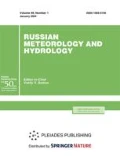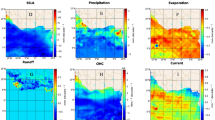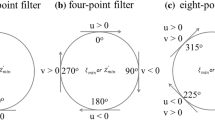Abstract
The cases of polar lows (PLs) over the Norwegian and Barents seas in 2013, in the vicinity of Severnaya Zemlya in 2015, and in the near-edge zone of the Laptev Sea in 2021 were analyzed using the reanalysis and the WRF-ARW model simulations. A combination of criteria was selected that are sufficient for identifying PLs and analyzing their size and intensity in a convenient and understandable form. These criteria are the estimates of helicity as an integral characteristic related to integral vortex formations and a kinematic vorticity number. Such criteria can be used to simplify the time-consuming procedure for collecting primary data on PL cases for machine learning.






Similar content being viewed by others
REFERENCES
A. V. Gavrikov and S. K. Gulev, “The North Atlantic High-resolution Regional Climate Model Experiment for Oceanic and Atmospheric Applications,” Okeanologiya, No. 6, 60 (2020) [Oceanology, No. 6, 60 (2020)].
E. S. Glebova, G. V. Levina, A. D. Naumov, and I. V. Trosnikov, “The Helical Feature Calculation for the Velocity Field of a Developing Tropical Cyclone,” Meteorol. Gidrol., No. 9 (2009) [Russ. Meteorol. Hydrol., No. 9, 34 (2009)].
I. A. Gurvich, M. K. Pichugin, and E. S. Khazanova, “Mesoscale Cyclogenesis over the Sea of Japan. Part II: Mesocyclonic Activity Associated with Atmospheric Blocking,” Sovremennye Problemy Distantsionnogo Zondirovaniya Zemli iz Kosmosa, No. 1, 17 (2020) [in Russian].
A. A. Lavrova, E. S. Glebova, I. V. Trosnikov, and V. D. Kaznacheeva, “Modeling the Evolution of the Family of Mediterranean Cyclones Using the Regional Model of the Atmosphere,” Meteorol. Gidrol., No. 6 (2010) [Russ. Meteorol. Hydrol., No. 6, 35 (2010)].
M. V. Kurgansky, “Vertical Helicity Flux in Atmospheric Vortices as a Measure of Their Intensity,” Izv. Akad. Nauk, Fiz. Atmos. Okeana, No. 1, 44 (2008) [Izv., Atmos. Oceanic Phys., No. 1, 44 (2008)].
M. V. Kurgansky, “Relationship between Helicity and Potential Vorticity in a Compressible Rotating Fluid,” Izv. Akad. Nauk, Fiz. Atmos. Okeana, No. 12, 25 (1989) [Izv., Atmos. Oceanic Phys., No. 12, 25 (1989)].
I. I. Mokhov, “Polar Lows,” in Intensive Atmospheric Vortices and Their Dynamics (GEOS, Moscow, 2018) [in Russian].
D. A. Iarovaia and V. V. Efimov, “Polar Low over the Barents Sea: Its Sensitivity to Surface Energy Fluxes and Condensational Heating,” Morskoi Gidrofizicheskii Zhurnal, No. 3, 36 (2020) [Phys. Oceanogr., No. 3, 27 (2020)].
S. Businger, “The Synoptic Climatology of Polar Low Outbreaks,” Tellus A, No. 5, 37 (1985).
A. M. Carleton, “On the Interpretation and Classification of Mesoscale Cyclones from Satellite Infrared Imagery,” Int. J. Remote Sens., No. 13, 16 (1995).
R. P. Davies-Jones, “Test of Helicity as a Forecast Parameter,” in Preprints, 16th Conference on Severe Local Storms, Kananaskis Park, AB, Canada, 1990 (Amer. Meteorol. Soc., 1990).
G. S. Golitsyn, “Polar Lows and Tropical Hurricanes: Their Energy and Sizes and a Quantitative Criterion for Their Generation,” Izv., Atmos. Ocean. Phys., No. 5, 44 (2008).
G. S. Golitsyn, “Tropical Cyclones and Polar Lows: Velocity, Size, and Energy Scales, and Relation to the 26°C Cyclone Origin Criteria,” Adv. Atmos. Sci., No. 3, 26 (2009).
D. G. Harley, “Frontal Contour Analysis of a “Polar” Low,” Meteorol. Mag., 89 (1960).
R. Hide, “Superhelicity, Helicity and Potential Vorticity,” Geophys. Astrophys. Fluid Dynamics, No. 1–3, 48 (1989).
M. J. Iacono, J. S. Delamere, E. J. Mlawer, M. W. Shephard, S. A. Clough, and W. D. Collins, “Radiative Forcing by Long-lived Greenhouse Gases: Calculations with the AER Radiative Transfer Models,” J. Geophys. Res. Atmos., No. D13, 113 (2008).
J. Jeong and F. Hussain, “On the Identification of a Vortex,” J. Fluid Mech., 285 (1995).
E. W. Kolstad, “A Global Climatology of Favourable Conditions for Polar Lows,” Quart. J. Roy. Meteorol. Soc., No. 660, 137 (2011).
E. W. Kolstad and A. J. Charlton-Perez, “Observed and Simulated Precursors of Stratospheric Polar Vortex Anomalies in the Northern Hemisphere,” Climate Dynamics, No. 7, 37 (2011).
M. Krinitskiy, P. Verezemskaya, S. Elizarov, and S. Gulev, “Machine Learning Methods for the Detection of Polar Lows in Satellite Mosaics: Major Issues and Their Solutions,” IOP Conference Series: Earth and Environmental Science, No. 1, 606 (2020).
M. Krinitskiy, P. Verezemskaya, K. Grashchenkov, N. Tilinina, S. Gulev, and S. Lazzara, “Deep Convolutional Neural Networks Capabilities for Binary Classification of Polar Mesocyclones in Satellite Mosaics,” Atmosphere, No. 11, 9 (2018).
M. Nakanishi and H. Niino, “Development of an Improved Turbulence Closure Model for the Atmospheric Boundary Layer,” J. Meteorol. Soc. Japan, Ser. II, No. 5, 87 (2009).
G. Noer, O. Saetra, T. Lien, and Y. Gusdal, “A Climatological Study of Polar Lows in the Nordic Seas,” Quart. J. Roy. Meteorol. Soc., No. 660, 137 (2011).
M. J. Onderlinde and D. S. Nolan, “Environmental Helicity and Its Effects on Development and Intensification of Tropical Cyclones,” J. Atmos. Sci., No. 11, 71 (2014).
E. A. Rasmussen, “A Case Study of a Polar Low Development over the Barents Sea,” Tellus A, No. 5, 37 (1985).
E. A. Rasmussen and J. Turner, Polar Lows (Cambridge Univ. Press, Cambridge, 2003).
A. Revokatova, M. Nikitin, G. Rivin, I. Rozinkina, A. Nikitin, and E. Tatarinovich, “High-resolution Simulation of Polar Lows over Norwegian and Barents Seas Using the COSMO-CLM and ICON Models for the 2019–2020 Cold Season,” Atmosphere, No. 2, 12 (2021).
M. Rojo, C. Claud, G. Noer, and A. M. Carleton, “In Situ Measurements of Surface Winds, Waves, and Sea State in Polar Lows over the North Atlantic,” J. Geophys. Res. Atmos., No. 2, 124 (2019).
R. Romero and K. Emanuel, “Climate Change and Hurricane-like Extratropical Cyclones: Projections for North Atlantic Polar Lows and Medicanes Based on CMIP5 Models,” J. Climate, No. 1, 30 (2017).
L. Schielicke, P. Nevir, and U. Ulbrich, “Kinematic Vorticity Number—A Tool for Estimating Vortex Sizes and Circulations,” Tellus A: Dynamic Meteorology and Oceanography, No. 1, 68 (2016).
M. R. Sinclair, “An Objective Cyclone Climatology for the Southern Hemisphere,” Mon. Wea. Rev., No. 10, 122 (1994).
W. C. Skamarock, J. B. Klemp, J. Dudhia, D. O. Gill, Z. Liu, J. Berner, W. Wang, J. G. Powers, M. G. Duda, D. Barker, and X.-Y. Huang, A Description of the Advanced Research WRF Model Version 4 (National Center for Atmospheric Research, Boulder, CO, USA, 2019).
G. Thompson, P. R. Field, R. M. Rasmussen, and W. D. Hall, “Explicit Forecasts of Winter Precipitation Using an Improved Bulk Microphysics Scheme. Part II: Implementation of a New Snow Parameterization,” Mon. Wea. Rev., No. 12, 136 (2008).
K. J. Tory, R. Dare, N. Davidson, J. McBride, and S. Chand, “The Importance of Low-deformation Vorticity in Tropical Cyclone Formation,” Atmos. Chem. Phys., No. 4, 13 (2013).
N. V. Vazaeva, O. G. Chkhetiani, and M. V. Kurgansky, “On Integral Characteristics of Polar Lows,” IOP Conference Series: Earth and Environmental Science, No. 1, 606 (2020).
M. I. Varentsov, P. S. Verezemskaya, E. V. Zabolotskikh, and I. A. Repina, “Evaluation of the Quality of Polar Low Reconstruction Using Reanalysis and Regional Climate Modeling,” Mod. Probl. Remote Sens. Earth Space, 13 (2016).
P. Verezemskaya, N. Tilinina, S. Gulev, I. A. Renfrew, and M. Lazzara, “Southern Ocean Mesocyclones and Polar Lows from Manually Tracked Satellite Mosaics,” Geophys. Res. Lett., No. 15, 44 (2017).
H. von Storch, H. Langenberg, and F. Feser, “A Spectral Nudging Technique for Dynamical Downscaling Purposes,” Mon. Wea. Rev., No. 10, 128 (2000).
M. Zahn, H. von Storch, and S. Bakan, “Climate Mode Simulation of North Atlantic Polar Lows in a Limited Area Model,” Tellus A: Dynamic Meteorology and Oceanography, No. 4, 60 (2008).
G. Zappa, L. Shaffrey, and K. Hodges, “Can Polar Lows be Objectively Identified and Tracked in the ECMWF Operational Analysis and the ERA-Interim Reanalysis?”, Mon. Wea. Rev., No. 8, 142 (2014).
Author information
Authors and Affiliations
Corresponding author
Additional information
Translated from Meteorologiya i Gidrologiya, 2022, No. 4, pp. 20-33. https://doi.org/10.52002/0130-2906-2022-4-20-33.
About this article
Cite this article
Vazaeva, N.V., Chkhetiani, O.G. & Durneva, E.A. Criteria to Identify Polar Lows. Russ. Meteorol. Hydrol. 47, 262–271 (2022). https://doi.org/10.3103/S1068373922040021
Received:
Revised:
Accepted:
Published:
Issue Date:
DOI: https://doi.org/10.3103/S1068373922040021




